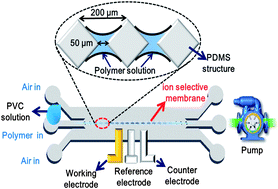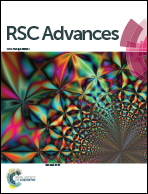A microfluidic chip for ammonium sensing incorporating ion-selective membranes formed by surface tension forces
Abstract
A microfluidic chip incorporating a series of polymeric ion-selective membranes (ISMs) is proposed for the detection of ammonium ions. In the proposed approach, the ISMs are formed by means of a simple flow-through forming technique, in which a polymer liquid doped with ammonium ionophores is injected into the microchip and attached to a series of diamond-like microstructures patterned along the center of the microchannel under the effects of surface tension forces and two neighboring sheath flows. The experimental results show that the proposed microsensor exhibits a linear response when detecting ammonium ions with a concentration of 10−4 to 103 ppm (R2 ∼ 0.9689). Furthermore, the detection limit is shown to be as low as 0.1 ppb. Finally, the time response when measuring 0.01 ppm of ammonium ions is just 4 s (95% standard), which is far faster than that of typical commercial ISE products (∼minutes) Overall, the results presented in this study show that the proposed microchip provides a low-cost yet highly-sensitive means of performing the continuous detection of ammonium ions.


 Please wait while we load your content...
Please wait while we load your content...